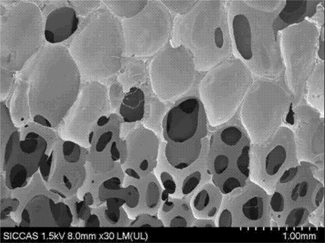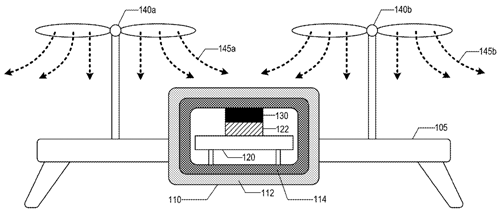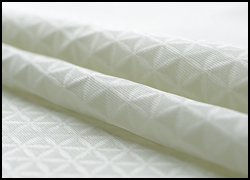 The Phase Change Matters e-mail newsletter is a weekly summary of the latest news and research on phase change materials and thermal energy storage. To subscribe, visit www.puretemp.com/subscribe. For more frequent updates, follow @puretemp on Twitter or visit the Phase Change Matters blog, www.puretemp.com/pcmatters.
The Phase Change Matters e-mail newsletter is a weekly summary of the latest news and research on phase change materials and thermal energy storage. To subscribe, visit www.puretemp.com/subscribe. For more frequent updates, follow @puretemp on Twitter or visit the Phase Change Matters blog, www.puretemp.com/pcmatters.
A team representing the Polytechnic University of Valencia, Spain, plans to use phase change material in the energy-efficient home it is building for Solar Decathlon Europe 2019. Azalea, one of 16 teams selected for the competition, is made up of 30 students and professionals representing fields such as architecture and engineering.
Microtek Laboratories of Dayton, Ohio, is providing Azalea with technical and financial support.
 “We are proud to be a sponsor of the Polytechnic team and the Azalea Project,” said Tim Riazzi, Microtek president. “As a company who practices and is concerned with environmental stewardship, we are excited about their efforts to create a sustainable ecological dwelling that will reduce our impact on the environment and reduce our energy consumption.”
“We are proud to be a sponsor of the Polytechnic team and the Azalea Project,” said Tim Riazzi, Microtek president. “As a company who practices and is concerned with environmental stewardship, we are excited about their efforts to create a sustainable ecological dwelling that will reduce our impact on the environment and reduce our energy consumption.”
Riazzi said Microtek provided Azalea with Micronal 28D (formerly Micronal 5528X).
“Instead of providing them with a final product,” Riazzi said, “we have worked with the team and decided that it would be better to provide them our dried Micronal product so that they could use it in the specific areas that they needed. We can say that they are incorporating it into a variety of elements/components of their wall and floor design, but they have asked us not to divulge the exact use of it because the competition is active. … We can say that we have provide them over 200 kg of material.”
SHIPPING | TRANSPORTATION
PCM with enhanced thermal properties developed for rail/truck container
 Yulong Ding, the University of Birmingham professor who directed the development of a rail/truck shipping container designed to keep perishables cold without a power supply, says his team developed an organic phase change material with enhanced thermal properties for the project. The PCM is designed to keep the temperature inside the container between 5 and 12˚ C for up to 120 hours. Ding, director of the university’s Center for Energy Storage, provided additional detail on the project in an interview this week.
Yulong Ding, the University of Birmingham professor who directed the development of a rail/truck shipping container designed to keep perishables cold without a power supply, says his team developed an organic phase change material with enhanced thermal properties for the project. The PCM is designed to keep the temperature inside the container between 5 and 12˚ C for up to 120 hours. Ding, director of the university’s Center for Energy Storage, provided additional detail on the project in an interview this week.
Q: Describe your organization’s role in the project.
A: It was funded by CRRC Shijiazhuang, a Chinese railway equipment manufacturer, and the project was collaborative. Our work at Birmingham included PCM materials development and fabrication, cold storage device design and testing, cold charging method and design. Work began in October 2017.
Q: What role did CRRC Shijiazhuang play?
A: CRRC was the project sponsor. Their work included manufacture and test of the device and cold charge device, installation of cold storage devices into large container, data-logging and IT, real application demonstration and testing (35,000 km combined road and railway testing across a wide climate zones).
Q: Can you briefly describe the testing methods and results?
A: I believe two standard containers were used, goods include all sorts of vegetables, flowers and fruits. Energy saving data have not been processed for the real tests but we do have testing data from labs, which is around 20 percent.
Q: Describe the PCM used in the application.
A: We used organic based PCM reformulated for enhanced thermal properties. Melting temperatures can be turned between -4 and 4 degree C, and the thermal storage capacity is >~200 kJ/kg.
Q: How big are the rail containers, typically, and how much PCM is used in each container?
A: We used the standard container for road transportation, which can be used for rail use. I prefer not to say the amount of PCM used, which may need approval from our sponsor.
Q: How is the PCM charged, and how long does it take to charge the PCM in a typical container?
A: We have a mobile charge device. The charging time is relatively short. The details will need our sponsor to approve before I can tell.
Q: In what material is the PCM contained (HDPE, film, metal)?
A: We used composite PCM contained in PCM storage device.
Q: How is the PCM deployed in the rail containers?
A: The PCM devices are installed inside the container.
Q: Does CRRC plan to manufacture the rail containers?
A: I doubt they would make the container.
PATENTS
Air-permeable sponge composition
 U.S. patent application 20190010300 (applicant Xilinmen Furniture Co. Ltd., Zhejiang, China):
U.S. patent application 20190010300 (applicant Xilinmen Furniture Co. Ltd., Zhejiang, China):

Enclosure cooling for thermal management of unmanned aerial vehicles
U.S. patent application 20190009878 (applicant Qualcomm Inc., San Diego, Calif.):
“Arrangements described herein relate to apparatuses, systems, and methods for a housing of an unmanned aerial vehicle (UAV), the housing includes but is not limited to a metallic porous material having a shape of an enclosure of the UAV, and a phase change material (PCM) provided in at least a portion of the metallic porous material. The metallic porous material and the PCM are configured to passively cool the UAV.”
Heat exchanger with phase change material
U.S. patent application 20190003369 (applicant Castrol Ltd., Pangbourne, Great Britain):
“In one embodiment, there is provided a heat exchanger for equipment, having: at least one phase change material; and at least one heat exchange interface for heat exchange between the phase change material and a fluid flowing within, into and/or from a replaceable fluid container for the equipment, the replaceable fluid container having at least one fluid port adapted to couple to a fluid circulation system of the equipment when the replaceable container is coupled to a dock.”
IN BRIEF
 • New Outlast products based on recycled materials were on display at the Heimtextil show in Frankfurt, Germany, this week. “In the new Outlast products,” the company said, “temperature-regulating technology is applied to base material (knitted fabric or nonwoven) which is produced from 100% recycled polyester textiles or PET bottles and therefore meets the Global Recycle Standard (GRS). Further products that use renewable materials for other components of the technology are planned to expand the portfolio in the near future.”
• New Outlast products based on recycled materials were on display at the Heimtextil show in Frankfurt, Germany, this week. “In the new Outlast products,” the company said, “temperature-regulating technology is applied to base material (knitted fabric or nonwoven) which is produced from 100% recycled polyester textiles or PET bottles and therefore meets the Global Recycle Standard (GRS). Further products that use renewable materials for other components of the technology are planned to expand the portfolio in the near future.”
• Tempur-Pedic says the latest version of its Breeze mattress line features a new “PureCool+ breathable phase change technology [that] absorbs excess heat and recharges faster to help the sleeper feel cooler when falling asleep.”
• Eindhoven University of Technology is seeking candidates for a Ph.D. position in nanoporous materials for thermal energy storage.
• Chemical & Engineering News is seeking candidates for a six-month science-writing editorial fellowship for 2019.
• A proposal to use microencapsulated phase change material to help motor vehicles run smoothly in extreme cold has been honored by Azerbaijan’s Ministry of Economy as the best youth startup project of the year. A team of chemical engineering students from Baku Higher Oil School developed the concept.
• The agenda has been posted for the Workshop on Energy Efficient Buildings & Thermal Energy Storage Systems to be held Jan. 24 at the University of Nottingham in the United Kingdom. Topics include “Enhanced geothermal borehole heat exchangers with PCMs,” “Innovative composite smart materials for heating, cooling and humidity control in buildings” and “Demonstration of the TESSe2b system in three demo sites.” The free, all-day workshop is part of the European Union-supported project TESSe2b.
• From LinkedIn: “Pluss Advanced Technologies Pvt. Ltd. is expanding its vendor development team for its PCM and polymers business. Candidates with prior experience in purchase or vendor management will be preferred, others will be considered too. Want to understand more about the opportunity? Please write to Ruchika Garg at jobs@pluss.co.in.”
• The world’s first grid-scale pumped heat energy storage is now in operation at Newcastle University. “The system consists of two containers – a cold store and a hot store – filled with gravel and an inert gas,” Utility Week reports. “They are connected via a reversible heat pump/engine. When surplus energy needs to be stored, gas is withdrawn from the cold store and compressed using an electrically-powered pump, thereby raising its temperature. The gas is injected into the hot store where the heat is transferred to the gravel. It is then withdrawn from the hot store, expanded to further lower its temperature and returned to the cold store. To recover the stored energy, the process is reversed.”
• Dominic Hyde, vice president of Credo on Demand at Pelican BioThermal, said the rental program increased its temperature-controlled container fleet size by 90 and increased revenue by 90 percent in 2018.
RESEARCH ROUNDUP
For our full list of recent academic research, see puretemp.com/academic. Here are highlights from the past week:
From Journal of Energy Storage:• Preparation of hydrophobic lauric acid/SiO2 shape-stabilized phase change materials for thermal energy storage
From Applied Thermal Engineering:
• Development of paraffin wax as phase change material based latent heat storage in heat exchanger
From Journal of Building Engineering:
• Comparison of EnergyPlus and IES to model a complex university building using three scenarios: Free-floating, ideal air load system, and detailed
From 4th International Conference on Renewable Energies for Developing Countries :
• Phase Change Materials in a Domestic Solar Hot Water Storage Tank of the Lebanese Market
• Numerical and experimental investigations of a PCM integrated solar chimney
• Integrating a High Solar Combi-Plus System using PCM Storage in a Smart Network: KSA Case Study
From International Journal of Advanced Research In Applied Sciences, Engineering and Technology:
• Solar Cooker with Heat Storage System: A Review [pdf]
From Solar Energy:
• Self-assembly of three-dimensional 1-octadecanol/graphene thermal storage materials
• Microstructure-guided numerical simulation to evaluate the influence of phase change materials (PCMs) on the freeze-thaw response of concrete pavements
From Energy Conversion and Management:
• Thermal management of Li-ion battery pack with the application of flexible form-stable composite phase change materials
• Experimental investigation on cylindrically macro-encapsulated latent heat storage for space heating applications
From International Communications in Heat and Mass Transfer:
• Experimental investigation on using a novel phase change material (PCM) in micro structure photovoltaic cooling system
• Experimental investigation on a novel composite heat pipe with phase change materials coated on the adiabatic section
• Preparation and effectiveness of composite phase change material for performance improvement of Open Graded Friction Course
NETWORKING
Connect with PCM experts and industry leaders on LinkedIn
 More than 1,400 people have joined a LinkedIn group devoted to the discussion of phase change material and thermal energy storage. The Phase Change Matters group is an interactive complement to the award-winning blog and newsletter of the same name.
More than 1,400 people have joined a LinkedIn group devoted to the discussion of phase change material and thermal energy storage. The Phase Change Matters group is an interactive complement to the award-winning blog and newsletter of the same name.
You are invited to join the group and connect with PCM and TES experts from around the world. New members this week include Paresh Shah, senior manager at Gujarat State Fertilizers & Chemicals Ltd., Vadodara, India; and Serhii Osypov, “author of the concept of hybrid energy storage technology,” Kiev, Ukraine.